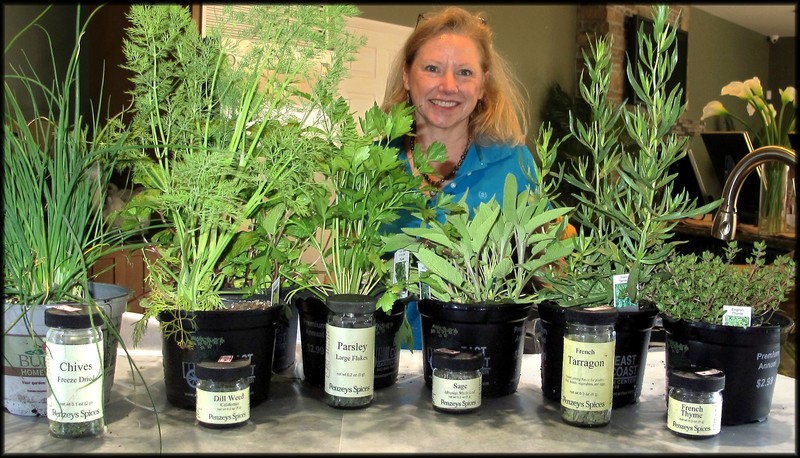Last weekend I had the chance to speak to a local radio audience about herbs during the East Coast Garden Center’s Flower Festival. We discussed the benefits of herbs in the landscape as a ground cover - creeping thyme and oregano are lovely - and their value in the kitchen, which was a good intro for my cooking demo that afternoon.
As you can see in the photo, we featured several different potted fresh herbs, comparing their potency and aroma with jars of dried herbs. Of course, since most herbs are cultivated as annuals, there will be times of the year when you’ll have to open a jar. If you’re looking for high-quality dried herbs, I always recommend Penzeys (www.penzeys.com).
When substituting one for the other, the rule of thumb is: one tablespoon of fresh herbs is equivalent to one teaspoon of dried. A few people in the audience were surprised to learn the dried form is more potent than fresh, but it’s because the drying process concentrates the flavors, and the fresh leaves are more delicate.
Based on the texture of their stems, some herbs are considered woody. This entails a different approach to harvesting the leaves. For herbs like tarragon, rosemary, sage and thyme, the leaves should be stripped from the stem and chopped. The stems should be discarded in the compost heap or tossed into the fireplace.
For herbs like parsley and dill, it isn’t a problem if some of the stems are chopped into the mix, but the less you use of the stem, the better the texture. For herbs like chives, the entire leaf can be used, but keep in mind these are a member of the onion family and the closer you get to the base and bulb, the sharper the flavor.
The timing for adding an herb to flavor your dish will vary depending upon the type of herb and the effect you are trying to create. For example, if you add thyme to a soup at the start of the simmering stage you will impart a very strong flavor. However, if you toss it in at the end of the cooking steps, as in the recipe below for glazed peas, the effect will be subtler.
Some of the charming aspects of herbs are their symbolism and historic legends. In Greek mythology, parsley sprang from the blood of a hero and was thereafter woven into garlands to crown the victors in games and battles. Sage, which is known botanically as salvio, has a reputation for healing properties and symbolizes domestic virtue. And, the Shakespeare fans will know that rosemary is for remembrance.
The four dishes prepared during the demo included a range of herbs in a variety of combinations, and all but one included a member of the allium family. Chives added a subtle bite to the cucumber and dill salad. Scallions (also known as green onions) added a sharper note to the taboulleh salad, seasoned with parsley and mint.
Minced shallots complemented the tarragon in the richly flavored glazed peas.
We spent a few minutes explaining the difference between grits and polenta. Both are ground from dried corn, but grits are typically ground from white hominy - dent corn that has been treated with lime to remove the hull. Polenta is made from flint corn, which has a hard center that gives the cooked dish its toothsome quality.
If you’re buying bulgur or cracked wheat for the taboulleh salad, look for a medium to small size grain. This will shorten the soaking step and give the dish a balanced texture with grains roughly the same size as the chopped herbs. You can use either curly parsley or flat-leaf parsley (also called Italian parsley) in this recipe.
Now that spring is here, it’s time to plant your herb garden - make sure it’s close to the kitchen.
Taboulleh
1 C cracked wheat
boiling water
1/2 C finely chopped mint
1 1/2 C finely chopped parsley
1 bunch finely chopped scallion
2 chopped tomatoes
1/2 C olive oil
2/3 C lemon juice
salt & pepper, to taste
Pour boiling water over cracked wheat to cover. After 30 minutes, check the wheat; it should be tender, but still firm to the bite. Cool the wheat and stir together with remaining ingredients.
Sage & Goat Cheese Polenta
4 1/2 C water or broth
1 t salt
1 t butter
1 C stone-ground corn
4 oz goat cheese
1 T finely chopped sage
Bring the water to a boil over high heat in a heavy saucepan. Add the salt and butter. Slowly pour in the corn meal, whisking to combine. Continue cooking over high for 5 minutes, then reduce heat to medium low and simmer another 15 minutes. Remove from heat; stir in cheese and sage. Spread in a shallow pan and allow to firm slightly before serving.
Cucumber Salad
3 cucumbers
2 t salt
1/4 t Tabasco sauce
1 T lemon juice
2 t chopped dill
1 T chopped chives
2/3 C sour cream
Pare and slice (or cube) the cucumbers; set aside. In a serving bowl whisk together the remaining ingredients. Add cucumbers and toss to combine. Serve chilled.
Glazed Peas
2 T butter
1/4 C minced shallots
pinch salt
2 C thawed frozen peas
2 t finely chopped tarragon leaves
1/2 t chopped thyme
1 t lemon zest
Melt butter in a skillet over medium low. Add the shallots and salt; sauté until tender, about 2 minutes. Reduce the heat to low and add the peas. Cook just until heated through. Add the remaining ingredients and cook another 5 minutes.
























































